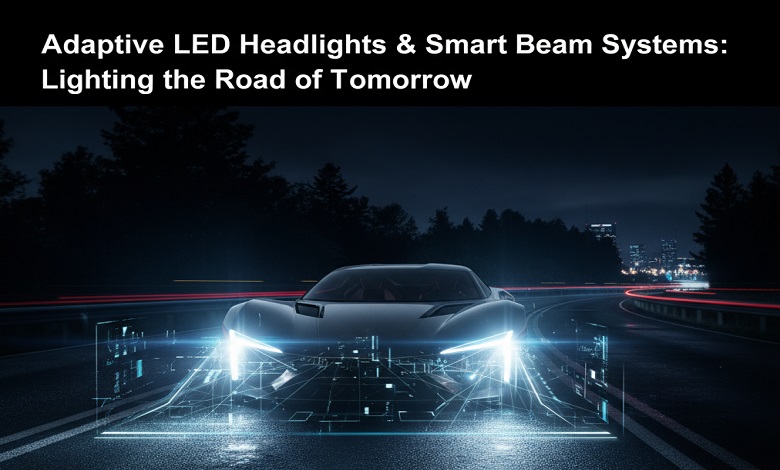Driving at night has always posed challenges—reduced visibility, glare from oncoming traffic, and fatigue. In recent years, automotive lighting technology has taken a giant leap forward, with Adaptive LED Headlights and Smart Beam Systems leading the charge. But what exactly are these systems, and how do they compare? Let’s dive in.
💡 What Are Adaptive LED Headlights?
Adaptive LED Headlights are an advanced lighting solution that adjusts the direction and intensity of your vehicle’s headlights according to driving conditions. Unlike traditional headlights, which shine in a fixed pattern, adaptive systems respond in real-time to:
-
Steering angle and speed
-
Oncoming traffic
-
Road curvature and elevation
This ensures optimal visibility without blinding other drivers. Imagine a headlight that “follows” the road—illuminating corners and bends just when you need it.
🛣️ Smart Beam Systems Explained
Smart Beam Systems, sometimes called automatic high beam systems, automatically switch between high and low beams depending on surrounding traffic. Using sensors and cameras, these systems detect oncoming vehicles and adjust light intensity to prevent glare, while still maximizing night-time visibility.
Some high-end systems even allow partial shading of high beams, illuminating the edges of the road while keeping the center dimmed for safety—a feature seen in brands like Audi, Mercedes-Benz, and BMW.
⚡ LED vs Adaptive LED: What’s the Difference?
Standard LED headlights offer brighter, energy-efficient illumination than halogen bulbs, but they remain static in pattern. Adaptive LEDs, on the other hand, combine the benefits of LEDs with dynamic adjustment, resulting in:
-
Enhanced cornering visibility
-
Reduced glare for oncoming drivers
-
Smart integration with vehicle sensors
In essence, adaptive LEDs are LEDs on smart steroids. If you’re upgrading from standard LEDs, expect a noticeable difference in night-time driving comfort.
🌐 Real-World Performance Comparison
1️⃣ Visibility
Adaptive systems outperform traditional LEDs by dynamically focusing light where it’s needed. On winding roads or highways with unpredictable curves, drivers reported up to 50% improved visibility in critical areas.
2️⃣ Safety
Smart Beam Systems reduce the risk of accidents caused by glare. According to recent traffic studies, vehicles equipped with adaptive lighting experience fewer night-time collisions—especially in urban settings with mixed traffic.
3️⃣ Energy Efficiency
Though adaptive systems require more sophisticated electronics, LED technology ensures that energy consumption remains low compared to halogens or xenon lights. Many manufacturers now integrate adaptive LEDs with eco-driving modes, further optimizing power use.
🔍 Trending Features in 2025
Today’s adaptive headlights come with innovative features that are shaping the automotive lighting landscape:
-
Matrix LEDs: Divide the beam into multiple segments, enabling precise control of light distribution.
-
Cornering Lights: Activate when turning or steering, illuminating blind spots.
-
Integration with Navigation Systems: Headlights adjust brightness and angle based on GPS-detected curves and road types.
-
Subscription-Based Upgrades: Some brands now offer software updates or light pattern customizations via subscription—like BMW’s “ConnectedDrive” lighting packs.
🚘 Popular Models Featuring Adaptive LED Headlights
-
Audi A6 / A8 – Equipped with Matrix LED technology and advanced cornering lights.
-
Mercedes-Benz E-Class – Features Adaptive Highbeam Assist Plus for seamless light control.
-
BMW 5 Series – Offers Laserlight and adaptive LED combo for maximum visibility.
-
Tesla Model S / X – Incorporates smart light adjustment via autopilot sensors.
🌟 Pros and Cons
Pros:
-
Superior night-time visibility
-
Reduces glare for other drivers
-
Enhances road safety
-
Adaptive to various driving conditions
Cons:
-
Higher cost compared to standard LED headlights
-
Potential repair or replacement cost can be expensive
-
Some advanced features may require subscription or software activation
🔧 Upgrade Options and Subscriptions
Many car owners can now retrofit adaptive LEDs on compatible vehicles. Brands like Philips Automotive Lighting offer upgrade kits with plug-and-play installation. Additionally, subscription-based updates are becoming more common, giving access to enhanced light patterns, cornering assistance, and even seasonal lighting adjustments.
🏁 Final Verdict
Adaptive LED Headlights and Smart Beam Systems are not just luxury features—they are safety and performance upgrades for modern driving. Whether navigating winding country roads or busy city streets, these systems improve visibility, reduce fatigue, and keep you—and other drivers—safer.
If you frequently drive at night, upgrading to adaptive LEDs or a smart beam system is a worthy investment. Coupled with subscription-based updates, these headlights are evolving into a dynamic, ever-improving driving companion.
💡 Pro Tip: Always check if your car model supports over-the-air lighting upgrades, as manufacturers are increasingly offering software-based enhancements that can improve your adaptive headlight experience without replacing hardware.















